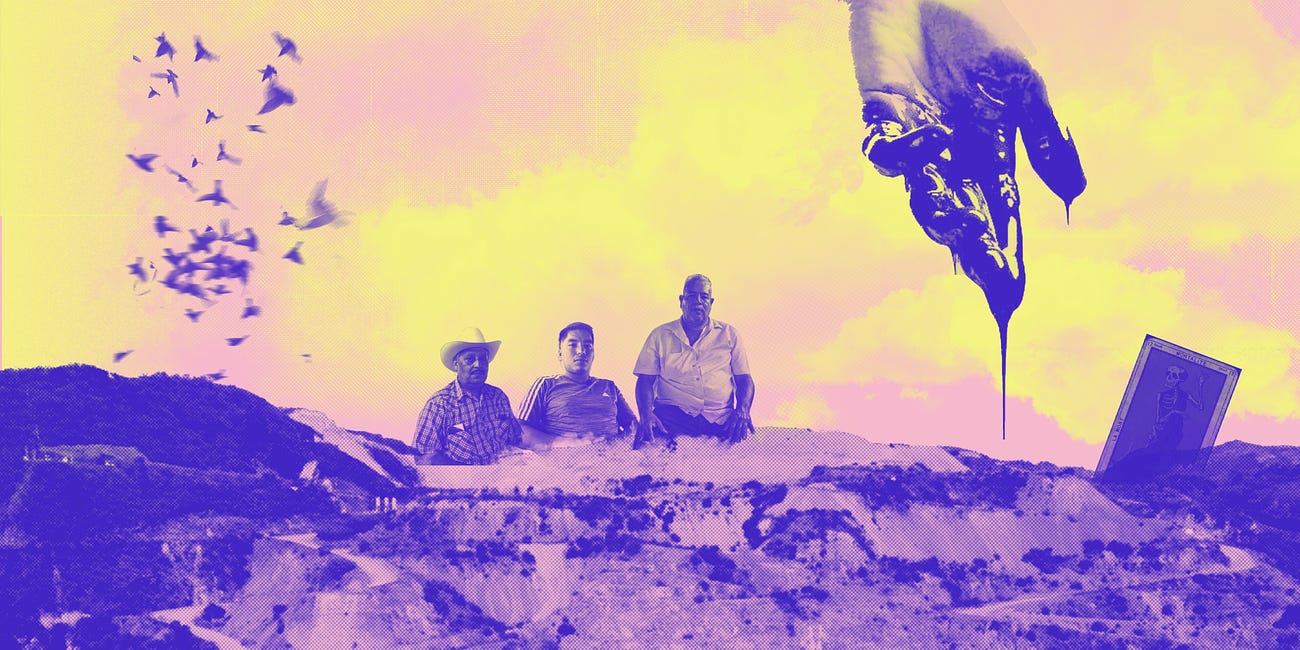Autonomy Amid Adversity: Confronting Cartels, Capital, and Collusion
Indigenous Communities Amidst the Plunder of Extractive Capital
by taller ahuehuete
✎ 9 minutes
The economic interdependence between «developed» and «developing» nations is articulated in intricate financial webs. In regions where resource extraction and mining play pivotal roles, the appreciation of local currencies has far-reaching implications.
The rapid appreciation of the Mexican peso in 2023 against the US dollar has driven up the costs of production as well as compromised the competitive advantage of exports. For mining companies that plunder the Global South, currency appreciation has serious financial results.
FresniIIo, Grupo México (controller of Southern Copper), and Toręx GoId reported higher operating costs this year due to inflation as well as the peso's appreciation, resulting in reduced gross profits and EBITDA1 for these mining giants. Tōrex GoId Resources is a Canadian-based mining company operating from the El Limón-Guajes Mine (ELG) in Guerrero, Mexico. With approximately 45% capex exposure2 to the Mexican peso, for every one-peso movement in the exchange rate, Torėx GoId Resources estimates a US $15 million impact on their capital throughout the project life.
The disappearance of the community leader, Oscar Hernández Romero, who campaigned to unionize T-GoId Resources, highlights the challenges faced by workers in the Global South. Organized staff and labor advocates are routinely met without protection or recourse, and this lack of accountability and oversight fosters an environment where kidnapping, forced disappearances, and intimidation are as regular as the sunrise.
August in Ostula
In the tranquil landscape of Santa María Ostula, nestled in México's Michoacán region, the informal drug industry has brought devastation to the lives of its originary inhabitants. The disappearance of Lorenzo Froylán de la Cruz Ríos, a member of the Guardia Comunal3, on August 1, 2023, serves as a harrowing reminder.
Ostula’s autonomous communal guard
In 2006, Santa María de Ostula solidified its alliance with the Zapatista Army of National Liberation, embarking on a new chapter marked by its designation as a "community in resistance" against government-led agrarian certification programs. This pivotal declaration emerged within a preexisting and protracted conflict concerning lands seized by ranchers during the early 20th century. The dispute became more pressing due to the heightened capitalist presence aimed at exploiting Ostula's communal territory for tourism and mining endeavors. The focal point of contention was underscored by the tragic demise of the community’s educator, who had been chosen to lead the commission advocating for communal land expropriation. His brutal assassination in July 2008 cast a grim shadow on the community's pursuit.
Merely a year later, a turning point occurred as indigenous children, women, men, and others encountered a harrowing confrontation involving gunshots. This event prompted Ostula to transform its communal guard into a self-defense force, thereby taking control of the disputed land. The act attracted national attention, reaching headlines in prominent newspapers across the country.
Lorenzo was seized by the Cártel Jalisco Nueva Generación (CJNG) at a checkpoint, an incident that highlights the profound vulnerabilities of those who endeavor to autonomously protect their communities from the horrors harbored by the complicity between the cartels, capital and the Mexican State.
Ostula, a bastion of Nahua indigenous fight for autonomy, stands as a testament to the transformative power of communal struggle. The Ostula Manifesto of 2009 marked a seminal moment in the indigenous movement, advocating for self-defense and inaugurating a chapter of resolute advocacy. The community's efforts to reclaim their communal lands from powerful interests of global and national capital were a poignant demonstration of their commitment to their ancestral heritage.
Ostula's unique geography places it in the crosshairs of rival cartel factions vying for control, as explained succinctly by Luis Hernández Navarro4. Los Viagras and the Jalisco Nueva Generación cartel (CJNG) engage in a territorial struggle, with their operations centering around the municipality of Aquila. The coast's strategic significance lies in its role as a conduit for drug trafficking, with beaches acting as gateways for drug shipments and clandestine landings for weapons and contraband. Amidst this chaos, another contest emerged — one for the exploitation of the region's natural resources. Mining conglomerates, armed with government-sanctioned and even tax-exempted concessions, routinely seek to extract the natural resources hidden underneath the bowels of the Earth5 from the community's 40,000 hectares. Tėrnīum, a steel manufacturer, commands 5,000 hectares within Ostula, an ominous fusion of mining interests, State concessions, and paramilitary groups in a coalition that has become regrettably commonplace in Mexico.
The plight of Santa María Ostula is deeply rooted in its history. The years between 2009 and 2014 witnessed a series of attacks on the community, with cartel groups collaborating with governmental bodies, orchestrating these attacks. The tragic death of Edilberto Reyes García, attributed to the 65th Infantry Battalion of the Mexican Army, was one of them.
In an interview6, representatives from the Community Council of Ostula elucidated the purpose behind the checkpoints situated at the entrance of their territory, and the roles of the communal guards. They underscored the tragic killing of Edilberto, a 12-year-old boy7, during a joint operation involving Mexican Army personnel, police, and marines, as they attempted to disband a highway blockade established by the Nahua community of Ostula.
The boy's death at the hands of the military deepened the community's mistrust of the State. Through a collective decision reached in their assembly, they reasserted their opposition to any external governmental intervention within their territories under the guise of providing security. In a conversation with Avispa Midia, the community members emphasized that their rationale for prohibiting state forces from entering is straightforward and rooted in this historical context.
Ostula's predicament is not an isolated incident. The region has witnessed a series of homicides and forced disappearances, that target not only Ostula but also neighboring communities such as San Miguel Aquila and Huitzontla. These acts have been linked to a group known as a collaborator of the mining firm Tėrnium, in a disturbing but rather common entanglement between paramilitary activities and global corporate interests. Furthermore, the presence of the 65th Infantry Battalion of the Mexican Army and the National Guard in the region, coupled with their inaction in the face of escalating violence, creates an atmosphere of impunity. In response to these grave circumstances, Ostula's community8 and collectives in solidarity have demanded immediate action9. Their plea included the safe return of Lorenzo Froylán de la Cruz Ríos.
As per data from the Mexican Secretariat of Economy, the municipality of Aquila hosts 101 mining concessions, out of which 58 are currently operational. The Mexican Geological Survey highlighted significant reserves of iron, silver, gold, copper, and manganese in the mining districts of Aquila and San Pedro. Las Encinas, S.A., a mining firm, holds a substantial concession spanning approximately 150,000 hectares across the Indigenous Nahua Sierra, extending from the south of Jalisco's Sierra of Manantlán to the Michoacán coast. The company engages in extensive iron extraction from these territories, operating an open pit mine in the Aquila municipality. The extracted materials are then processed at the Alzada Station in Colima for the production of agglomerates and iron sintering at the pelletizing plant owned by Tėrnium Mexico S.A. de C.V.
Ostula’s Community Council frequently highlights10 the mining sector's interests as a factor driving the State's attempt to dismantle their autonomous security system. Notably, Michoacán stands as a principal contributor to Mexico's iron ore production. In 2013, iron ore exports were briefly halted due to concerns that the port of Lázaro Cárdenas, situated a relatively short distance from Ostula, was being exploited by the Knights Templar Cartel for the informal export of iron ore to China.
Yet regardless of whether the profits of extractive capitalist firms are rising or falling, the situation is particularly dire for originary, peasant, and marginalized communities, as they are increasingly unable to partake in traditional agricultural practices due to the economic 'development' driven by mining projects.
Historically reliant on the land and its resources for subsistence, the originary and peasant societies confront the violent mass displacement imposed by mining activities, which deprive the population not only of access to their ancestral territories, but lead to biotic crisis via environmental degradation, indiscriminate termination of whole species, and contamination of crucial resources such as water bodies. Unable to survive after the seizure of their land and the resulting usurpation of their traditional forms of subsistence and interaction with their natural surroundings, the form of life of many originary communities finds itself in an existential conflict with the extractivist capitalist plunder, even as the latter cloaks itself in the mystifying euphemisms of 'development' or 'green energy.'
⚠ Update: We regret to inform you that the Nahua Indigenous Community of Santa María Ostula confirmed "the violent execution of Lorenzo Froylán de la Cruz Ríos, a member of the Community Guard of Santa María Ostula." See our translation of the communiqué below.
Attacks against the Nahua Indigenous Community of Santa María Ostula continue
The Nahua Indigenous Community of Santa María Ostula denounced "the violent execution of Lorenzo Froylán de la Cruz Ríos, a member of the Community Guard of Santa María Ostula."
Updated: August 10, 2023.
"With deep sorrow and anger, we report that today, around 00:20, at kilometer 129+700 of the Coalcomán-Aquila highway, in the municipality of Chinicuila, we found the lifeless body of our brother and comrade Lorenzo Froylan de la Cruz Ríos, who on August 1 had been lifted by a commando from the Jalisco Nueva Generación Cartel (CJNG) in the municipality of Coalcomán. The cartel finally executed him extrajudicially and savagely,” described community members in the statement.
In a press release, the Nahua Indigenous Community of Santa María Ostula (NICSMO) indicated that "this brutal execution by the cartel occurred in plain sight and with the absolute indifference of all levels of government. The secretary of government in Michoacán in particular, Carlos Torres Piña, currently is concerned with nothing other than to promote his political career through proselytizing disguising such activities as work tours”.
The NICSMO denounced "the collusion of the National Guard stationed in Chinicuila and Coalcomán, the Attorney General's Office of the State of Michoacán de Coalcomán and the Civil Guard, as well as various state officials", with the informal drug-trafficking group.
“We demand that the state government and the Attorney General of Justice in Michoacán do their job and carry out the investigation of the facts — at the time denounced by the family of the deceased today — and accountability from those guilty of this terrible atrocity, as well as the dismantling” of the cartel group.
The same request for accountability was extended to the perpetrators of the murder of Isaul Nemesio Zambrano, Miguel Estrada Reyes, Rolando Magno Zambrano, Eustaquio Alcalá Díaz, and Juan Medina, as well as the safe return of Antonio Diaz and Ricardo Lagunes.
The Nahua Indigenous Community of Santa María Ostula denounced on August 7 the forced disappearance of Lorenzo Froylán De La Cruz, a member of the Community Guard. Through a public statement, they highlighted that, in the face of the violence carried, both the Community Guard of Santa María Ostula, together with the self-defense groups and community guards of Aquila and Coahuayana, "will reinforce actions to combat and put an end to the presence of informal drug-trafficking industry throughout the region”.
"This group seeks, at all costs, to expand the activities of the mining company Tėrnium, and thus achieve economic gain by providing the corporation with protection in Michoacán and Colima by allowing it to expand their political networks within the governments of these two states.
Our community is organized and united to face these attacks. We have our Community Guard and our institutions,” they highlighted in the communiqué published on their social networks.
Related Essays:
Lithium Lust and Dry Days Ahead
by taller ahuehuete ✎ 4 minutes Lithium Lust and Dry Days Ahead Renewable energy technologies constituted a prominent portion of Canada's primary energy supply, accounting for about 17.3% of the country's total energy mix as of 2019. On the other hand, southward, in eastern Mexico, the recent droughts in San Luis Potosí have resulted in significant consequ…
Blood, thus far into the bowels of the Earth
Ternium mining company's involvement in the disappearance of Ricardo Lagunes and Antonio Díaz, an investigation by Heriberto Paredes. → The original version, in Mexican-Castilian is available here. Translated and illustrated by taller ahuehuete, in solidarity









